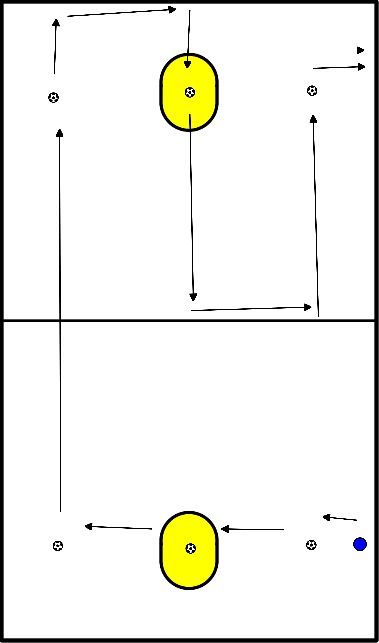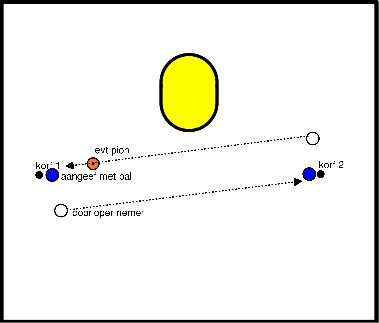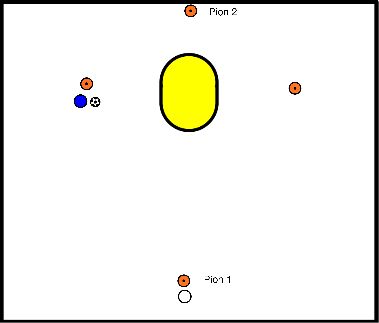Korfball exercises for u12
- Set up six baskets in two lines of three.
- Under each basket, a fixed declarer.
- The other players stand on the sideline across the first line of baskets.
- The other players take a walk-through ball on the side of the first three baskets.
- Followed by a ball in front of, behind and in front of the basket on the next baskets. (See diagram).
- Then all players do the same round, reversed and back again, after which they exchange players and do another round back and forth.

- Start with 2 attackers 1 defender
- Attackers will throw over and the defender must try to intercept the ball
- When the attackers have passed the ball 7 times a defender comes on
- Then it is 2 against 2
- If the attackers have passed the ball again 7 times, another defender comes on
- If the defenders have intercepted 3 times, an attacker is added.
- Player 1 in front of the basket runs 2 metres out and receives the ball
- Player 2 runs out from under the basket
- Player 1 plays the ball back to player 2
- Player 1 takes the walkthrough ball
- You need 2 baskets per 4 or 5 persons.
- The poles are opposite each other.
- There are fixed helpers with the ball.
- You take the run-through on the post opposite the post where you started.
- When you have made the run through, you start again from the pole where you just made the run through and continue to the other side.
- Change after x goals or after so many minutes.
- Then the passers take the runners and the takers pass to the other players.
- Pay attention to the passing and the technique of the runthrough.
- If necessary, put a cap or a pawn where the children should get the ball.

- Player 1 starts at a few meters from the basket to start a distance shot.
- The ball is caught by player 2 and player 1 makes a run through.
- The ball is caught again and player 1 makes a short chance from behind the basket.
- If none of these 3 chances are seated, the player must do it again.
- If one of the 3 chances is placed, the next player may try again.
- One player for one minute
- Place four hats around the basket at about 3/4 of a meter, one in front, one on the left, one on the right and one behind the basket.
- The shooter starts in front of the basket.
- The receiver stands with the ball under the basket.
- The active player receives the ball and shoots, then walks directly to the next pawn next to the basket. Walk left for 1 minute and shoot on the move at each pawn.
- After one minute, switch from catch to active player.
- Do the same but walk to the right.
- Start and finish line, caps are scattered around the field.
- The number of caps is the number of players in the team x 2.
- Caps are brought to the end line one by one, the team that finishes first wins.
- At pawn 1
- touch the groundTouch the ground, jump up and stretch all the way. We do this 10 times.
- RUN TO THE POLE.
- Pole
- next you take a dodge at the pole.
- RUN TO PAWN 2.
- Pole 2
- 5 sit ups.
- RUN TO POLE
- Pole
- take a run through at the pole from behind the basket
- RUN TO PAWN 1
- Pawn 1
- Push-ups 5 times
- RUN TO POLE
- Pole
- Take the penalty throw
- RUN TO PAWN 2
- Pole 2
- Shot four meters behind the basket
- After the intercepted shot, receive the ball and throw it back to the receiver, who is standing next to the basket.
- Sprint to pion 1 and start again
- We do this 3 times
- Keep the post clear and keep your distance from each other.
- But each time change under the post.

- Make a circle at the level of your head on the wall (with sidewalk chalk)
- Make the circle about the same size as a basket.
- Now stand 3 or 4 meters away from the circle.
- Now throw the ball with your left against the wall and catch it with your right hand.
- Do this for one minute.
- The ball must not bounce on the ground.
- If it is too easy, stand further away or try to throw the ball faster. If the exercise is too difficult, try to catch the ball with two hands, but still throw with one hand
- Or stand a little closer to the wall. (Outdoors exercise)
- Stand with the team in a circle with one person in the middle.
- From the outside the ball is played inwards.
- When you pass, you run after the ball.
- From the centre, run after the ball to the outside again
- The ball must not hit the ground and is played around as quickly as possible
- If it does get to the ground, the person who threw the ball will take a penalty throw
- The rest of the team plays on
Variation:
- Alternating the preferred hand with the non-preferred hand
- Reduce or extend the distance to the centre.
- fast balls or airballs.
- with multiple balls
- We're gonna pass as a group.
- We stand in two rows opposite each other.
- We'll start as follows:
- Pass with two hands, catch with two hands.
- Pass with your good hand, catch with two hands.
- Pass with your good hand, catch with your good hand.
- Pass with the lesser hand, catch with two hands.
- Pass with your lesser hand, catch with your right hand.
- With the whole team, catch and throw well, if you don't do this and the ball falls to the ground 5 times.
For variation, you can also add special ways of throwing (behind the back, through legs, etc.)
In short: practicing various shooting variants in a fun competition form.
- Organization: per group a basket and a ball, the baskets are preferably (but not necessary) arranged in a circle or rectangle.
- The number of persons per group is less important (but all groups are about the same size).
- The first assignment for the groups is: score 10 goals.
- When you have completed this assignment, the person who scored the last goal runs to the trainer to pick up the next assignment.
- Which group completed all assignments first?
- The trainer walks around, encouraging, or correcting.
- He has a piece of paper with him with a row of assignments on it.
- When someone comes to pick up the next assignment, first ask which one has just been done (this can vary considerably over time) and then hand out the next assignment.
- An example list: 10 walk-through balls, 15 penalty shots, 5 8-meter shots, 10 walk-through balls from behind the basket, 5 dodge balls next to the pole, 10 6-meter shots.
- Everything is possible of course, a lot of momentum is gained if the number of goals to be scored is kept small.
- 10 walk-through balls
- 20 small oppertunities
- 6 remote shots
- 10 penalty throws
- 1 backwards








